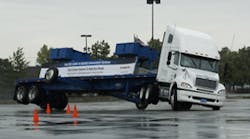WASHINGTON, D.C. Don Ellmore guns the throttle, shifting his International tractor up for speed in searing heat here along a wide swath of empty parking lot alongside Robert F. Kennedy (RFK) memorial stadium. He turns on his blinker to merge right and suddenly an alarm sounds, with a yellow warning light mounted on the cab’s right roof pillar blinking rapidly to tell him there’s a vehicle in his blind spot.
That vehicle—a gold minivan—suddenly accelerates, rapidly changes lanes to move in front on him and then hits the brakes. Again, alarms scream at Ellmore—with a small oval screen displaying a blinking orange car at him. The warning gives him time to slow down and avoid rear-ending the minivan—a type of crash that makes up more than 40% of truck-car accidents, according to research done by Delphi, the company that manufacturers the radar- and imaging-based warning systems on Ellmore’s truck.
Finally, Ellmore swings the tractor around and heads back to his starting position at over 45 mph when he starts drifting out of the white lines painted on the tarmac below. This time the imaging system broadcasts a “rumble strip” sound while its screen flashes a white line on its left side.
“This is all about giving commercial drivers more tools to help them avoid some of the most common accidents out on the road,” Craig Tieman, global product marketing manager for Delphi’s warning systems division, told FleetOwner at a vehicle safety technology demonstration hosted by the Motor and Equipment Manufacturers Assn. (MEMA).
“We did a study that found 65% of all truck accidents revolve around three causation factors: rear-end collisions, lane departure crashes, and lane change collisions,” Tieman stressed, explaining how the Delphi technology in Ellmore’s test truck could benefit other drivers. “You have to remember that a fully loaded tractor-trailer is going to need 400 feet to stop and at 55 mph you’re traveling at 64 feet per second. That’s why technology like this is so important in terms of improving truck safety.”
A variety of safety system providers were on hand at the MEMA event largely to lobby Congressional lawmakers and their staffers visiting from Capitol Hill to try and find ways to help encourage trucking companies, transit agencies and other vehicle operators to add such safety technology to their equipment.
“[Safety system] payback can be a difficult thing to calculate for most over the road fleets,” explained Chad Robinson, national sales manager for the ESB brake monitoring system developed by MGM Brakes. “So we’re asking government leaders to explore tax incentives and encourage insurance breaks to help fleets justify the cost of putting safety technology on their trucks.”
The cost for fleets to install safety technology on tractor-trailers certainly isn’t cheap. But neither are the accidents such systems are designed to prevent, Kevin Romanchok, product line director-electronics for Bendix’s vehicle stability systems, told FleetOwner.
“It costs around $2,000 to install our basic stability package on a tractor-trailer and $300 to $400 more than that for the full stability system, which adds in extra sensors for better snow and wet pavement control,” he said.
“However, you have to look at how much a truck accident can cost a fleet,” Romanchok stressed. “A typical crash with injuries can cost a fleet $300,000 or more—one involving a fatality upwards of $3 million or more. For hazmat carriers, a rollover can cost $500,000 to $1 million alone without injuries or fatalities added in. In each case, the costs of just one crash would have more than paid for the installation of our technology on all of the fleet’s trucks.”
Allan Korn, chief engineer for Meritor Wabco, added that he understands carriers must look at safety technology from a business perspective and therefore must justify the cost. However, he believes trucking companies must also weigh how just one crash affects everything from freight claims to their insurance ratings.
“If I had a device that helped a fleet reduce fuel consumption, they’d be able to put on their trucks, test it, and calculate the savings easily,” he told FleetOwner. “With safety, it’s much more difficult, because how do you put a financial value on crashes that never happen because the technology helped a driver avoid it?”
Korn pointed to the various safety systems by ArvinMeritor, Meritor Wabco’s parent company, on display at the MEMA event: Roll Stability Control (RSC), Electronic Stability Control (ESC), Roll Stability Support (RSS), plus Collision Mitigation systems (CMS), which is an extension of the company’s Adaptive Cruise Control/Collision Warning system.
“About 99% of the time, these systems are simply monitoring and recording data—they are not doing anything until a severe event occurs,” Korn explained.
“The key thing, however, is that point when something unexpected happens and a driver must react: Maybe they took an exit ramp too fast, or a car cuts them off in traffic. That’s when these technologies step in and help a driver potentially avoid a crash,” he said. “They can’t save a vehicle all the time—sometimes an event is just too severe—but they can prevent a lot of crashes from happening simply because the technology can react faster than a human can. And in those cases, it can save fleets a lot of money.”
To comment on this article, write to Sean Kilcarr at [email protected]




